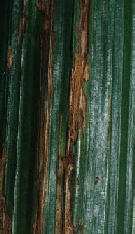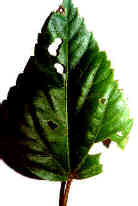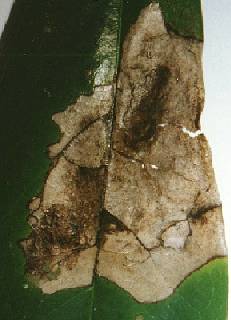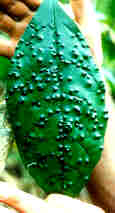



Insect
Signs of Damage (2)
Leaf Damage
go to main menu
| Leaf and needle mines are caused by insects with chewing mouthparts Feeding occurs inside the leaf or needle on the mesophyll, between the lower and upper epidermis. The different types of mines are described according to their shape as linear mine, serpentine mine, blotch mine, digitate mine, leaf blister, needle mine or a combination of one or more. |  |
| External leaf or needle damage is caused by insects with chewing mouthparts feeding externally on the leaf or needle. A leaf or needle chewed from the outside, called free feeding , is sometimes left with only the tough veins and the middle rib as skeleton (skeletonizing). A small patch eaten through all layers of the leaf, creating a hole in the leaf is referred to as hole feeding. If only one surface of the leaf is affected resulting in a more or less transparent ‘window’, we talk about window feeding. |   |
| Stippling damage is caused by the piercing and sucking action of hemipterans and mites. Usually these animals inject saliva for the external digestion of the plant juices prior to their ingestion. The toxic effect of the saliva results in small, circular ‘dead’ spots on the leaf. | |
| Shelter feeding refers to foliage that is modified into a shelter in which an insect hides and feeds. Either one or several leaves are tied together with a silk thread or web, either by one or more caterpillars (leaf/needle tying, web-enclosed foliage), or folded or rolled and tied together (leaf folding and rolling). The piercing-sucking action of insects can make the leaf crinkle and curl around the insect, thus providing shelter (crinkled leaf). Sometimes, if eggs are laid into the tissue of a leaf, the affected area starts to grow abnormally like a tumour. Those structures are called leaf or petiole galls. The immature stages of gall-forming insects develop and feed inside a gall. Galls can also be induced by saliva injected during the piercing-sucking action of Hemiptera and mites. |  |
back to previous page
go to glossary
go to main menu
© Michael F. Schneider, 1999